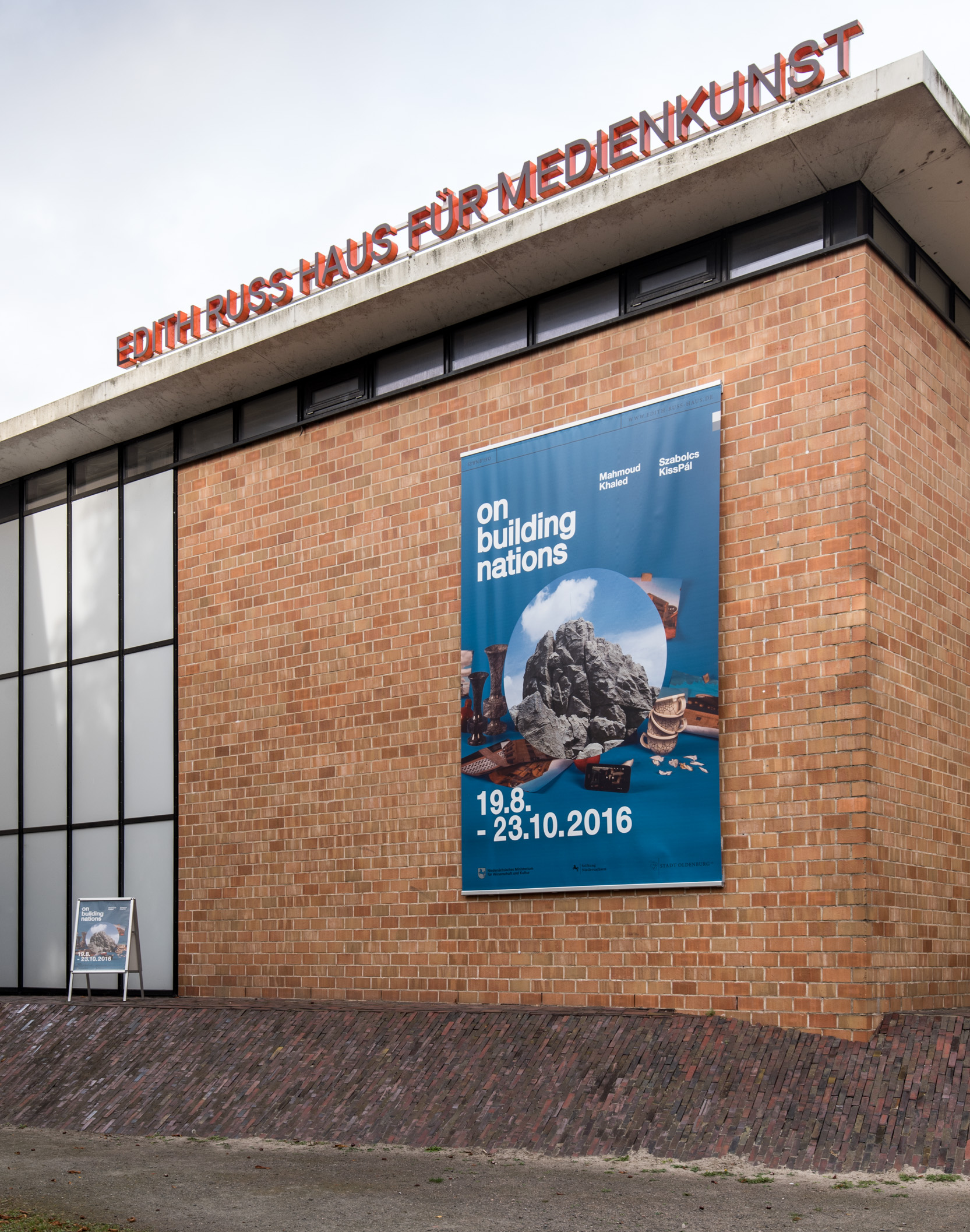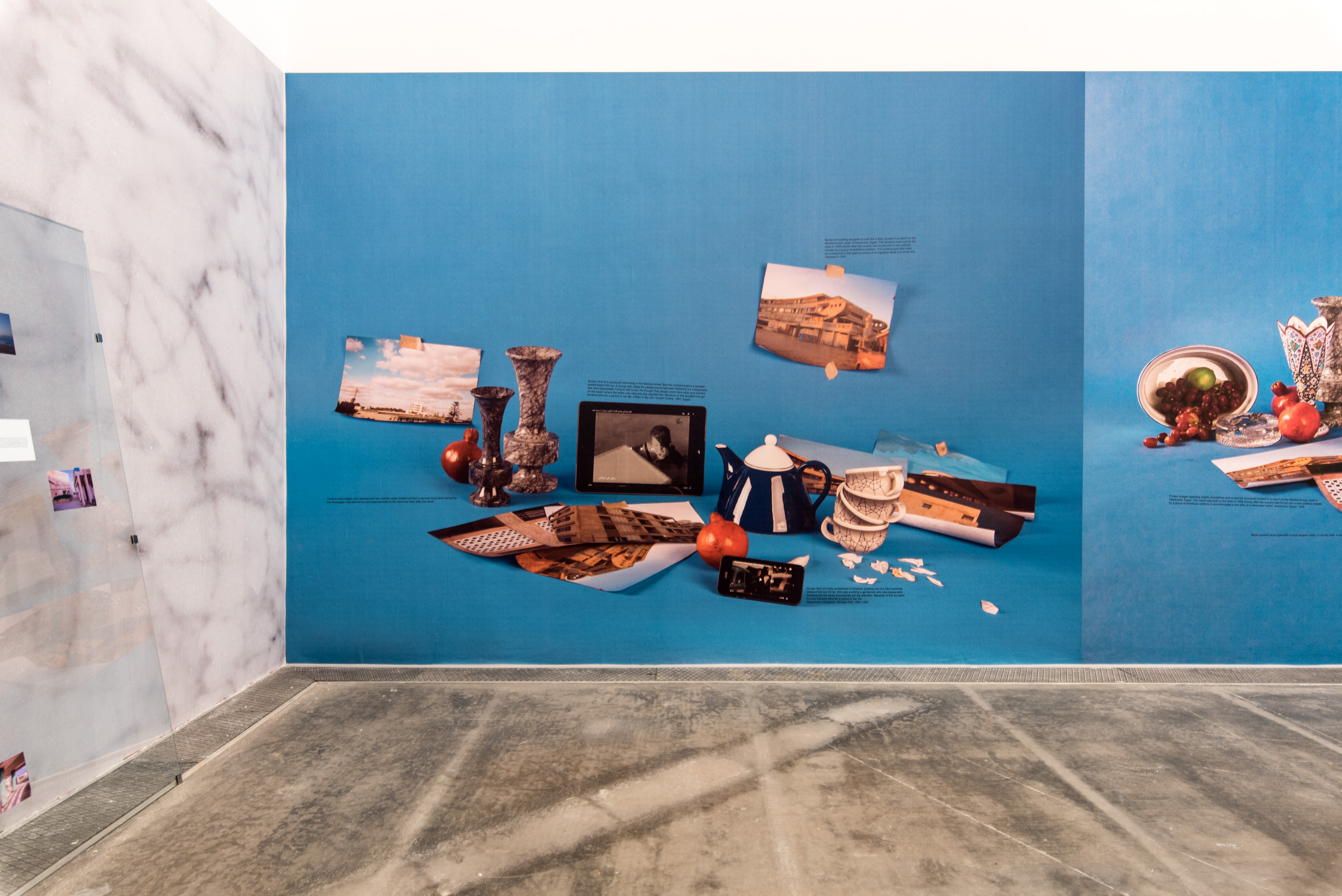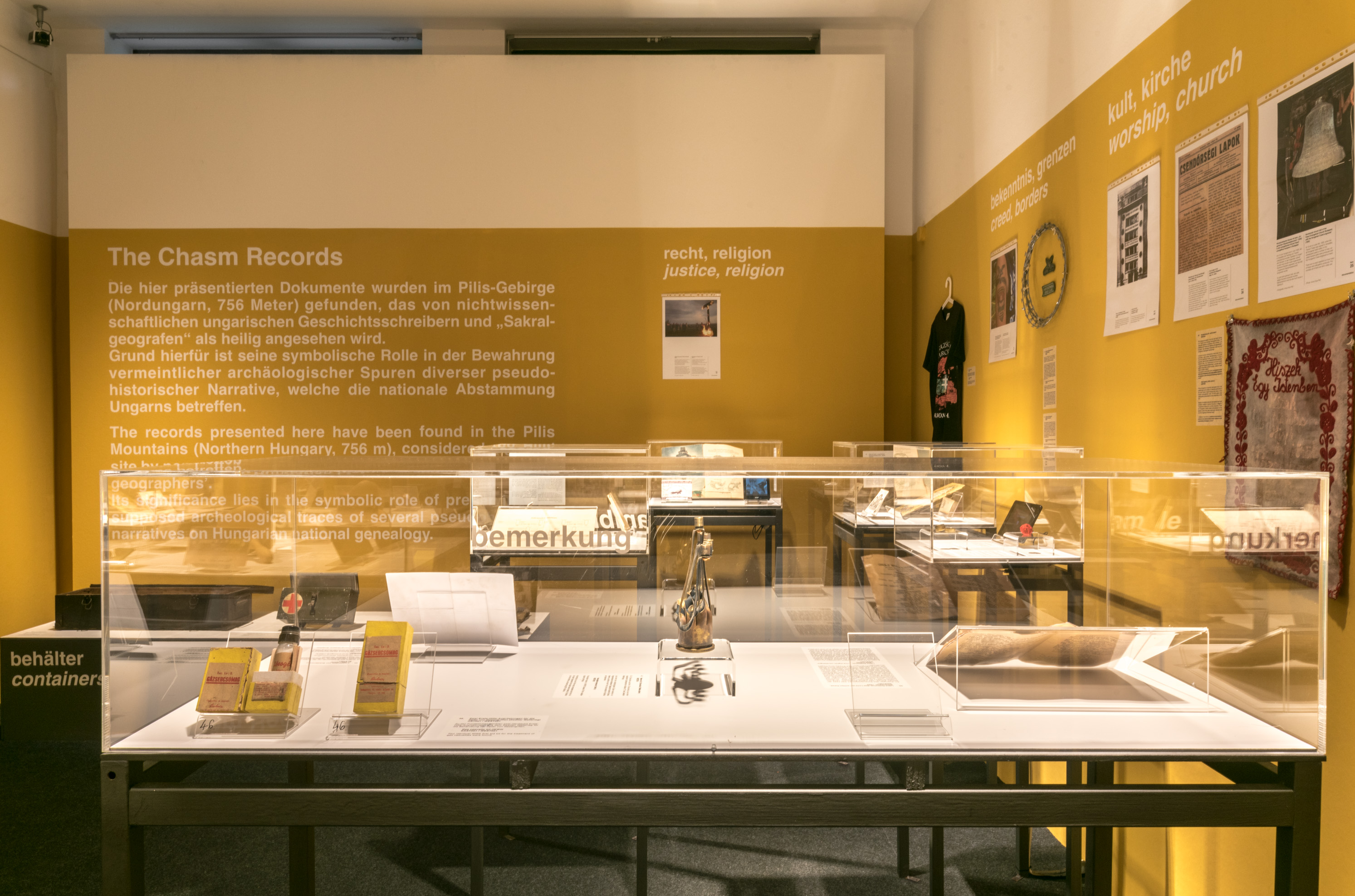On Building Nations
The thematic double exhibition On Building Nations by Mahmoud Khaled and Szabolcs KissPál revisits the notion and complex mechanisms of the construction of national identities. Both artists come from complicated political contexts—Egypt and Hungary—where their work is highly influenced by social surroundings that are in flux and in turmoil. Their art creatively investigates past histories, engaging viewers in rethinking our current global conditions in which questions at the global level challenge the narratives of national constructs, radically changing the relation between the two. Both projects work to reshape and rebrand the white-cube setting of the Edith-Russ-Haus exhibition spaces, turning one into a memorial and the other into a museum-like environment that provides space for videos, photographs, and objects.
A New Commission for an Old State is a new site-specific exhibition by Mahmoud Khaled that bears formal and conceptual similarities with memorials. This form of commemoration provides the framework for the complex narratives that unfold in the artist’s new body of work. Khaled’s research-based artistic strategy focuses on three iconic artifacts within the Egyptian context. The first is a gated summer resort in Alexandria called Maamoura built by the state shortly after Gamal Abdel Nasser came to power to accommodate the new elite of the “rebranded” (post-1952) Egypt, a significant yet painfully understudied monument of modern architecture in Egypt. The second is a landmark text titled Maamoura’s Victimswritten by Judge Hassan Jalal who was a harsh critic of the Egyptian monarchy. His text serves as a reference to the political layers of the exhibition, bridging different epochs in the history of modern Egypt. Jalal published a report on the atrocities, horrendous conditions and systematic tortures in a prisoner camp on the King’s properties, which later became the land on which Maamoura was built. Through this testimony the supporters of the new military regime of Gamal Abdel Nasser ironically wanted to prove that the monarchy erected its legitimacy on oppression and blood. The haunting similarities between the methods of the monarchy and republic puts the document in a completely different light, making it even more relevant when read in the present.
The third artifact is a 1961 film by Youssef Chahine titled A Man in My Life, a remake of Douglas Sirk’sMagnificent Obsession from 1954. A Man in My Life, a relatively unknown work within Chahine’s filmography, started production in Maamoura a few months after it officially opened in 1959. The story revolves around the life of a fictitious architect who is known for his remarkable modernist style and who has built one of Maamoura’s most memorable buildings, which is used as a backdrop in the opening scene of the film. This character is portrayed as a fighter for social justice who is given a prominent position to achieve this; nevertheless, due to past misdeeds, he considers himself a criminal. Chahine’s film talks about love, violence, modernity, justice, heroism, and the political context and architectural style of Egypt at that time.
Khaled’s new body of work metaphorically touches upon these topics by utilizing building materials such as glass and marble that have been widely used in state-sanctioned architectural projects in Egypt in the past 30 years. These materials are mixed with photos, texts, screenshots, murals, and found-footage videos—all presented together in an imagined memorial-like installation. A New Commission for an Old State is fueled by the artist’s urgent and insistent desire to understand the relationship between his generation and the powers that have been ruling the country for the past 64 years.
From Fake Mountains to Faith (Hungarian Trilogy) is a docu-fiction project by Szabolcs KissPál, the final two episodes of which have now been completed under commission from the Edith-Russ-Haus. This project is in line with the artist’s previous works that investigate political communities not as inherited or essentialist but rather as complexly constructed entities. Through different media and representational techniques, KissPál revisits and manipulates a series of problematic and ever-changing symbols that attempt to create a homogenous and rather oppressive idea of the Hungarian nation. At the center of his investigations is the authoritarian “illiberal” Hungarian state policy: the project aims to analyze, describe, and translate into an international perspective the anatomy of the political and cultural philosophy that operates as its ideological basis.
KissPál’s exhibition comprises two docu-fiction videos and an installation that presents a fictitious museum setting. These works establish interconnections within a larger historical and cultural framework between the three major elements of the above-mentioned philosophy: the symbolism of the “ethnic landscape” and political geography, the romantic historiography of national myths of origin, and Turanism as a re-emerging form of political religion. Amorous Geography, the first part of the Hungarian Trilogy, deals with one of the most persistent—though repressed—motifs of Hungarian historical memory: the national trauma caused by the Treaty of Trianon (1920). This event had a long-lasting effect on the development of Hungarian society, shaping its sociopolitical structures, defining its cultural positions, and fueling its sociocultural frustrations throughout the 20th century and up to the present day. The associative chain of historical references in The Rise of the Fallen Feather looks at how the symbolism of a totem bird—the mythological Turul—affected 20th century Hungarian history through an amnesiac, yet magical, collective memory from very early times up to the present ideology of “blood and motherland.” The Chasm Records takes the form of a museum display, presenting items from a fictitious archeological find. Through references to historical objects and relics dating from Hungary’s interwar period, the political formation of the nation is revealed—a process still being completed in contemporary Hungarian society. The narrative presentation of the archeological objects identifies the two main constitutive elements of national becoming: political religion as a tool, and the objective of exclusion from collective memory.
Curated by Edit Molnár & Marcel Schwierin.
Related Publications
 YouTube:
YouTube:
Activate service and agree with the data transfer to YouTube.Informations to the privacy policy and the release revocation you will find here: Datenschutzerklärung YouTube:
YouTube:
Activate service and agree with the data transfer to YouTube.Informations to the privacy policy and the release revocation you will find here: Datenschutzerklärung
ARTIST TALK with Szabolcs KissPál / KÜNSTLER*INNENGESPRÄCH mit Szabolcs KissPál (2016)
ARTIST TALK with Mahmoud Khaled / KÜNSTLER*INNENGESPRÄCH mit Mahoud Kahled (2016)
The thematic double exhibition On Building Nations by Mahmoud Khaled and Szabolcs KissPál revisits the notion and complex mechanisms of the construction of national identities. Both artists come from complicated political contexts—Egypt and Hungary—where their work is highly influenced by social surroundings that are in flux and in turmoil. Their art creatively investigates past histories, engaging viewers in rethinking our current global conditions in which questions at the global level challenge the narratives of national constructs, radically changing the relation between the two. Both projects work to reshape and rebrand the white-cube setting of the Edith-Russ-Haus exhibition spaces, turning one into a memorial and the other into a museum-like environment that provides space for videos, photographs, and objects.
A New Commission for an Old State is a new site-specific exhibition by Mahmoud Khaled that bears formal and conceptual similarities with memorials. This form of commemoration provides the framework for the complex narratives that unfold in the artist’s new body of work. Khaled’s research-based artistic strategy focuses on three iconic artifacts within the Egyptian context. The first is a gated summer resort in Alexandria called Maamoura built by the state shortly after Gamal Abdel Nasser came to power to accommodate the new elite of the “rebranded” (post-1952) Egypt, a significant yet painfully understudied monument of modern architecture in Egypt. The second is a landmark text titled Maamoura’s Victimswritten by Judge Hassan Jalal who was a harsh critic of the Egyptian monarchy. His text serves as a reference to the political layers of the exhibition, bridging different epochs in the history of modern Egypt. Jalal published a report on the atrocities, horrendous conditions and systematic tortures in a prisoner camp on the King’s properties, which later became the land on which Maamoura was built. Through this testimony the supporters of the new military regime of Gamal Abdel Nasser ironically wanted to prove that the monarchy erected its legitimacy on oppression and blood. The haunting similarities between the methods of the monarchy and republic puts the document in a completely different light, making it even more relevant when read in the present.
The third artifact is a 1961 film by Youssef Chahine titled A Man in My Life, a remake of Douglas Sirk’sMagnificent Obsession from 1954. A Man in My Life, a relatively unknown work within Chahine’s filmography, started production in Maamoura a few months after it officially opened in 1959. The story revolves around the life of a fictitious architect who is known for his remarkable modernist style and who has built one of Maamoura’s most memorable buildings, which is used as a backdrop in the opening scene of the film. This character is portrayed as a fighter for social justice who is given a prominent position to achieve this; nevertheless, due to past misdeeds, he considers himself a criminal. Chahine’s film talks about love, violence, modernity, justice, heroism, and the political context and architectural style of Egypt at that time.
Khaled’s new body of work metaphorically touches upon these topics by utilizing building materials such as glass and marble that have been widely used in state-sanctioned architectural projects in Egypt in the past 30 years. These materials are mixed with photos, texts, screenshots, murals, and found-footage videos—all presented together in an imagined memorial-like installation. A New Commission for an Old State is fueled by the artist’s urgent and insistent desire to understand the relationship between his generation and the powers that have been ruling the country for the past 64 years.
From Fake Mountains to Faith (Hungarian Trilogy) is a docu-fiction project by Szabolcs KissPál, the final two episodes of which have now been completed under commission from the Edith-Russ-Haus. This project is in line with the artist’s previous works that investigate political communities not as inherited or essentialist but rather as complexly constructed entities. Through different media and representational techniques, KissPál revisits and manipulates a series of problematic and ever-changing symbols that attempt to create a homogenous and rather oppressive idea of the Hungarian nation. At the center of his investigations is the authoritarian “illiberal” Hungarian state policy: the project aims to analyze, describe, and translate into an international perspective the anatomy of the political and cultural philosophy that operates as its ideological basis.
KissPál’s exhibition comprises two docu-fiction videos and an installation that presents a fictitious museum setting. These works establish interconnections within a larger historical and cultural framework between the three major elements of the above-mentioned philosophy: the symbolism of the “ethnic landscape” and political geography, the romantic historiography of national myths of origin, and Turanism as a re-emerging form of political religion. Amorous Geography, the first part of the Hungarian Trilogy, deals with one of the most persistent—though repressed—motifs of Hungarian historical memory: the national trauma caused by the Treaty of Trianon (1920). This event had a long-lasting effect on the development of Hungarian society, shaping its sociopolitical structures, defining its cultural positions, and fueling its sociocultural frustrations throughout the 20th century and up to the present day. The associative chain of historical references in The Rise of the Fallen Feather looks at how the symbolism of a totem bird—the mythological Turul—affected 20th century Hungarian history through an amnesiac, yet magical, collective memory from very early times up to the present ideology of “blood and motherland.” The Chasm Records takes the form of a museum display, presenting items from a fictitious archeological find. Through references to historical objects and relics dating from Hungary’s interwar period, the political formation of the nation is revealed—a process still being completed in contemporary Hungarian society. The narrative presentation of the archeological objects identifies the two main constitutive elements of national becoming: political religion as a tool, and the objective of exclusion from collective memory.

























